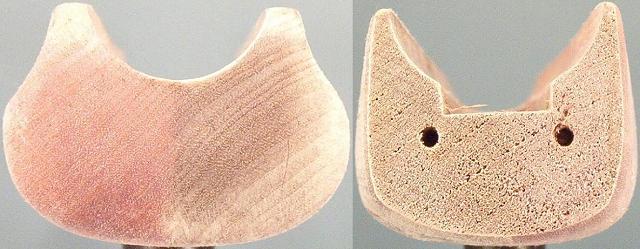This gun makes an excellent demonstration example because the stock is made of a light colored wood, Maple I believe, and will show dark areas well to indicate the effectiveness of the two stripping methods.
The forend shown below will be stripped:
The right side of the forend (top portion in photo) will be stripped with Paint And Varnish Remover and the left side of the forend (bottom portion in photo) will be stripped with Oven Cleaner (e.g. EASY-OFF). Oven Cleaner (sodium hydroxide also called as lye) is in some ways more gentle than Paint And Varish Removers (methylene chloride also called dichloromethane) because it can be used to strip paint from plastic (polystyrene) models without harming the plastic, whereas Paint And Varish Removers will melt the plastic. Oven Cleaner removes embedded dirt, grease, and oil well but also tends to remove natural oils in wood and can cause damage to wood fibers and cause the wood to turn darker. It is worthy to mention that some antinque refinishers use lye to darken new wood used in repairs.
In all stripping processes, the stripper is applied liberally. After 10 minutes, the wood is scrubbed with a brush then thoroughly washed with Dawn Dish Soap and rinsed in hot water.
First Stripping
The photo below shows the results 12 hours after stripping the forend once:
Note that not all the finish as been removed by either stripper:
Second Stripping
The photo below shows the results 12 hours after stripping the forend a second time:
Note that both sides still have small spots of finish remaining. Notice too that the side stripped with Oven Cleaner reveals the wood grain but the Paint And Varnish Remover does not, apparently because a pre-finish coating has been applied during the factory finishing process.
Third Stripping
The photo below shows the results 12 hours after stripping the forend a third time:
Note that both sides are stripped of all finish. Notice too that the Oven Cleaner has caused wood fibers to loosen and raise, especially on the checkering.
Final Results
The photo below shows the ends of the forend to show stripping results on the wood end grain:
The photo below shows the forend after sanding surface and end grain areas with 320 grit sandpaper till the factory pre-finish coating was removed and then sanding those areas with 400 and then 600 grit sandpaper:
Note that the Oven Cleaner darkened wood appears to extend into the wood deeper than the factory pre-finish coating.
The photo below shows the forend after wiping the surface with Mineral Spirits:
Wiping with Mineral Sprits gives an indication of what it would appear like after applying a clear finish.
Recommendations
Both chemicals do a good job of removing finish. Oven Cleaner removes oils more effectively but also removes some natural oils, can cause wood fibers to loosen and raise, and can cause the wood to turn darker. Paint And Varnish Remover removes the finish without removing natural oils but also does not remove lubricating grease and oils etc. and may not remove pre-finish coatings. Because of the above findings, the recommendation is as follows:
If the stock does not contain an excessive amount of absorbed grease and oil, Paint And Varnish Remover is recommended. If the stock contains an excess of absorbed dirt, grease, and oil, Oven Cleaner will remove these contaminations from the wood well but should be used sparingly due to the harshness of the chemical on wood.
When stripping a checkered finish, it may be virtually impossible to remove factory pre-finish coatings with the Paint And Varnish Remover. Oven Cleaner will remove the pre-finish coating but will damage the wood fibers and cause the wood to turn darker. Therefore, be fore warned and extremely cautious if using Oven Cleaner to strip wood.






